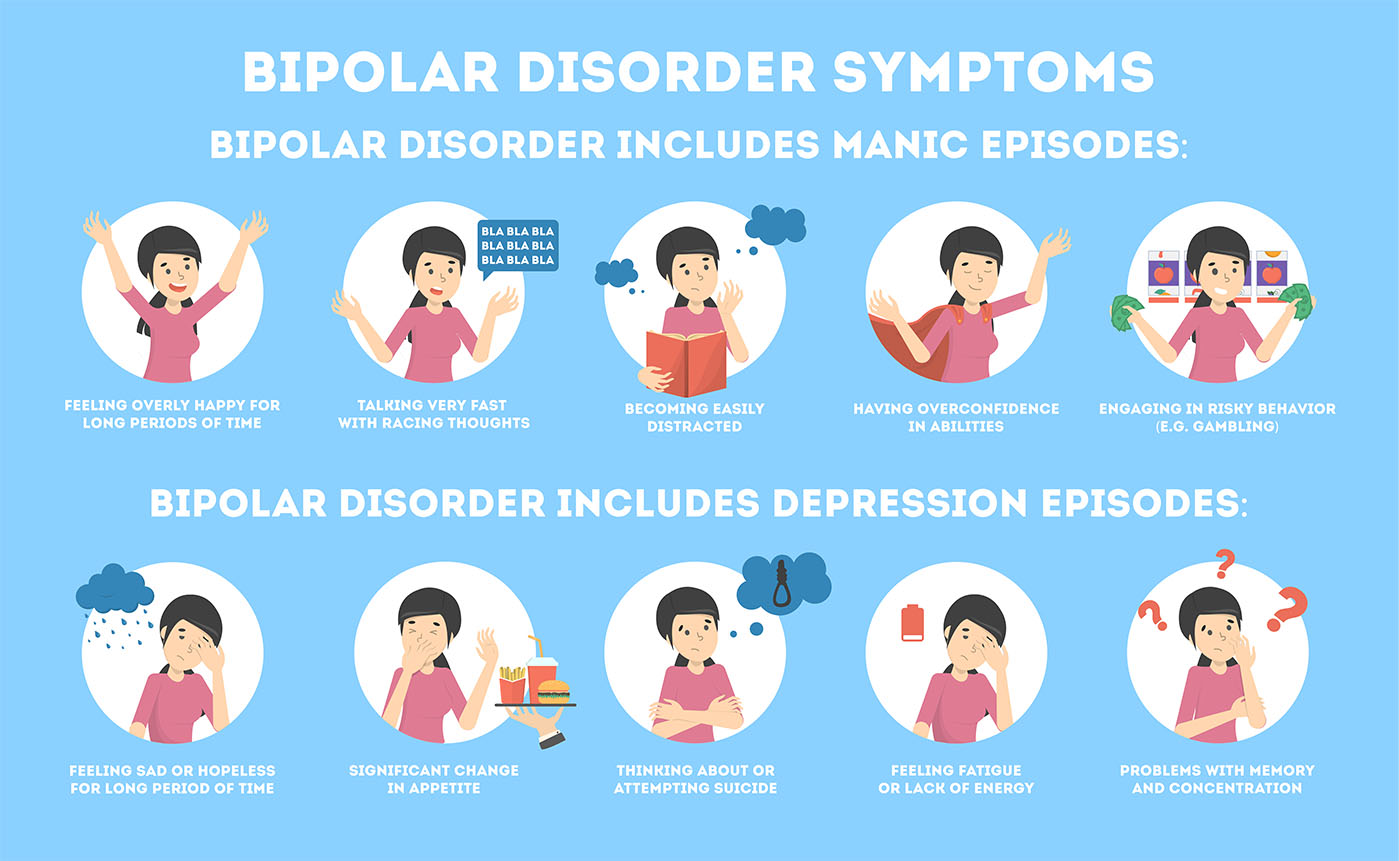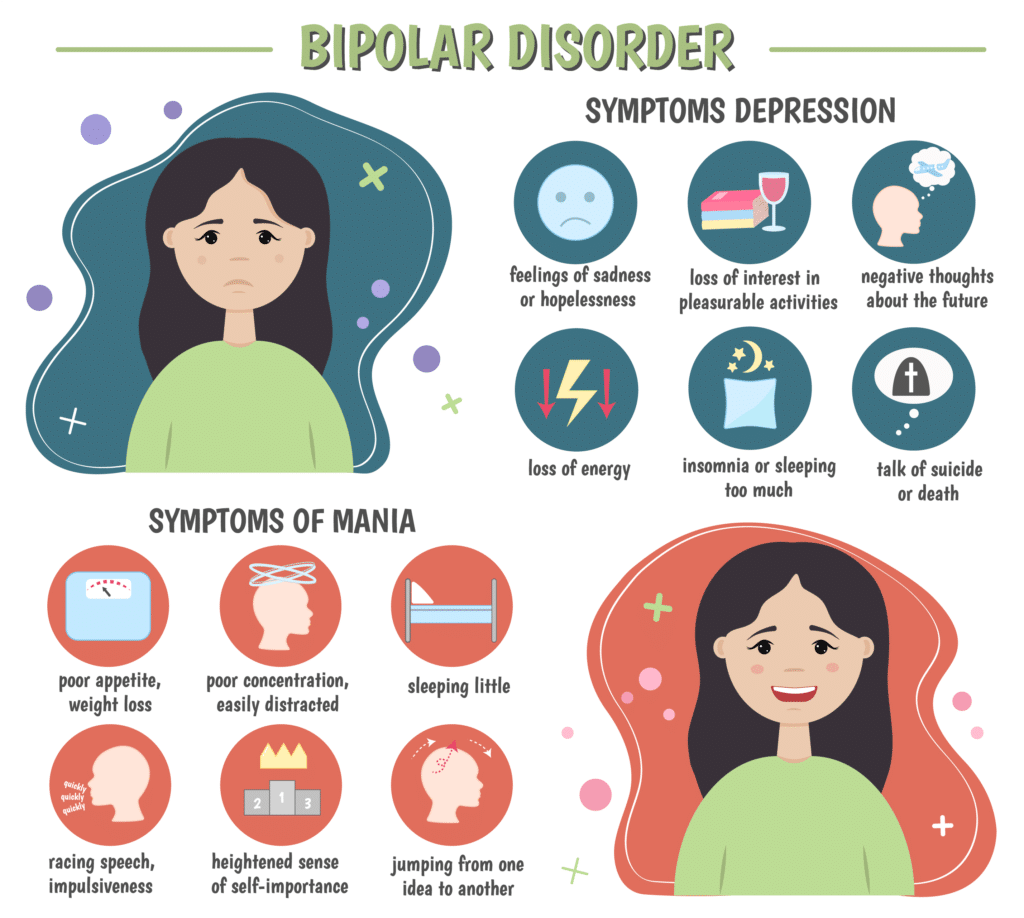
Bipolar disorder, also known as manic-depressive illness, is a mental health disorder in which a person experiences extreme and cyclical mood swings. These changes can include the highest highs (manic phases), during which the person feels extremely energetic, optimistic and active, and the deepest lows (depressive phases), when the person experiences sadness, feelings of hopelessness, or even suicidal thoughts.
These changes are much more radical than the normal mood swings of everyday life and can last for weeks or even months. They can also have a significant impact on a person's quality of life, performance and relationships. In addition, those with bipolar disorder often experience intermediate periods of normal mood between manic and depressive phases.
Causes of the disorder
Bipolar disorder has multifactorial and still not fully understood causes. However, researchers have identified several factors that may increase the risk of developing bipolar disorder.
Genetics: Bipolar disorder often runs in families. Research suggests that certain genes may increase the risk of bipolar disorder. This does not mean that if a family member has bipolar disorder, you will necessarily have the disorder as well, but your risk is higher.
Structural changes in the brain: Neuroimaging studies show that the brains of people with bipolar disorder may differ from those without the disorder. This may suggest that brain structure and function may contribute to the development of bipolar disorder.
Environmental factors: Although genetics play an important role in the risk of developing bipolar disorder, environmental factors may also play a role. Stress, trauma, or serious shocks, such as the loss of a loved one, can trigger a first episode of bipolar disorder.
Hormone and neurotransmitter imbalances: An imbalance of neurotransmitters -- chemicals that help transmit signals between brain cells -- is also thought to contribute to bipolar disorder. In addition, hormonal imbalances can also play a role in the development of this condition.
Although these factors can increase the risk of bipolar disorder, it is important to note that many people with these factors do not develop bipolar disorder. Bipolar disorder and its onset are complex processes involving both genetic and environmental factors.
What are the symptoms of the disease?
Bipolar disorder has very different symptoms that depend on whether the person is experiencing a manic or depressive phase.
Symptoms of a manic phase may include:
Increased energy level, activity
Less need for sleep
A very good mood, or an extremely high mood, but one that changes very quickly
Increased self-confidence
Talking more than usual or rapid, unintelligible speech
A light-hearted attitude towards risky things that are not usually characteristic of the person, such as spending money unnecessarily
Concentration and attention disorders
Symptoms of a depressive phase may include:
Feelings of sadness, emptiness, or hopelessness
Loss of energy
Sleep problems, including sleeping too much or too little
Not being able to enjoy things that once gave pleasure
Fear or anxiety
Difficulty in making decisions, concentrating
Changes in eating habits, such as excessive or loss of appetite
Suicidal thoughts, attempts or plans
Sometimes people with bipolar disorder can experience symptoms of both phases at the same time - this is called a "mixed episode".
Also, some people diagnosed with bipolar disorder may experience psychotic symptoms, including grandiose delusions (such as thinking they are famous or have special powers) or persecutory delusions.
Each person can experience the symptoms of bipolar disorder differently, and the severity of symptoms can vary from mild to severe. Symptoms may change over time and require professional evaluation and treatment.

How is bipolar disorder diagnosed?
Diagnosing bipolar disorder can be difficult because its symptoms are often mistaken for other illnesses, such as depression. The diagnosis is usually made by a psychiatrist who uses various methods, including psychological tests, physical examination.
According to the Diagnostic and Statistical Manual (DSM-5) of the American Psychiatric Association (APA), to be diagnosed with bipolar disorder, a person must experience at least one episode of mania or hypomania. Mania is a highly elevated, hyperactive and unrealistic, high mood, while hypomania is a milder form of mania. In addition, the patient may experience one or more episodes of depression.
Bipolar disorder is a universal disorder that affects approximately 1-3% of the world's population. This means that about 45-135 million people worldwide may have this disorder.
Bipolar disorder can occur at any age, but most commonly occurs in childhood or adolescence. About half of all cases begin before the age of 25.
Bipolar disorder affects men and women equally, regardless of race, ethnicity, or social class. However, women may experience more depressive episodes and men more manic episodes.
Treatment
Treatment for bipolar disorder is a long-term process aimed at controlling symptoms and improving quality of life. Doctors usually use a combination of pharmacological and non-pharmacological treatment.
Pharmacological treatment includes:
Mood stabilizers such as lithium and valproate, which can help control symptoms of mania and depression.
Antipsychotics such as olanzapine and quetiapine can be used to control manic symptoms.
Antidepressants, along with mood stabilizers or antipsychotics, may be used to treat symptoms of depression. However, they must be used with caution as they can cause manic episodes.
Benzodiazepines can sometimes be used to help with anxiety and nervousness.
Non-pharmacological treatment includes:
Cognitive Behavioral Therapy (CBT), which can help a person become aware of their thoughts and feelings, and teach effective ways to deal with stress and problems.
Family therapy, which can help the person and their loved ones cope with the disorder and improve their relationships.
Learning healthy life skills such as regular exercise, healthy eating, getting enough sleep and avoiding alcohol and drugs.
It is important to note that bipolar disorder is individual and each person needs a different treatment plan. In addition, treatment can take a long time - it can be a lifelong process. However, with the right treatment, most people with bipolar disorder can effectively manage their condition and lead fulfilling lives.
Treatment should be prescribed and monitored by a qualified healthcare professional and should be regularly reviewed and adjusted according to the patient's needs and symptoms. It is also important for the person diagnosed with bipolar disorder and their family to be well informed about the disorder in order to effectively cope with its challenges.

Bipolar disorder is a serious mental health condition characterized by mood swings that include episodes of mania (or hypomania) and depression. Although this disorder can be a challenge for both the person diagnosed with bipolar disorder and their loved ones, it is important to understand that bipolar disorder can be well managed.
Despite the severity of the condition, many people with bipolar disorder can lead fulfilling and productive lives. But you need the right support and the right treatment. Therefore, it is very important that people who suspect they may have bipolar disorder seek health care professionals for evaluation and treatment.
Finally, education and awareness about bipolar disorder is very important. This not only helps the person with the disorder, but also their family, friends and community to better understand how to help them and how to support them on this journey.
Sources of information:
American Psychiatric Association. (2013). Diagnostic and Statistical Manual of Mental Disorders (5th ed.). Arlington, VA: American Psychiatric Publishing.
Merikangas KR, Jin R, He JP, et al. Prevalence and correlates of bipolar spectrum disorder in the world mental health survey initiative. Arch Gen Psychiatry. 2011.
National Institute of Mental Health. (2017). Bipolar Disorder.
Geddes JR, Miklowitz DJ. Treatment of bipolar disorder. Lancet. 2013.
Hofmann SG, Asnaani A, Vonk IJJ, Sawyer AT, Fang A. The Efficacy of Cognitive Behavioral Therapy: A Review of Meta-analyses. Cognitive therapy and research. 2012.
# bipolinis sutrikimas # depresija # manija






